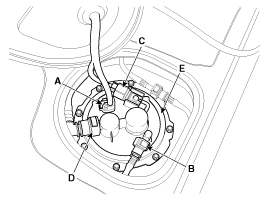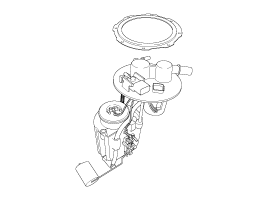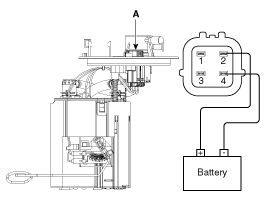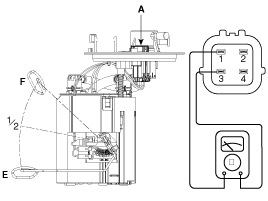 Hyundai Veloster: Fuel Pump. Repair procedures
Hyundai Veloster 2011-2017 Service Manual / Fuel System / Fuel Delivery System / Fuel Pump. Repair procedures
Hyundai Veloster: Fuel Pump. Repair procedures
Hyundai Veloster 2011-2017 Service Manual / Fuel System / Fuel Delivery System / Fuel Pump. Repair procedures
Removal
| 1. |
Release the residual pressure in fuel line (Refer to ÔÇťRelease
Residual Pressure in Fuel LineÔÇŁ in this group).
|
| 2. |
Remove the rear seat [LH] (Refer to ÔÇťSeatÔÇŁ in BD group).
|
| 3. |
Remove the fuel pump service cover (A).
|
| 4. |
Disconnect the fuel pump connector (A).
|
| 5. |
Disconnect the fuel feed tube quick connector (B).
|
| 6. |
Disconnect the fuel tank pressure sensor connector (C).
|
| 7. |
Disconnect the vapor tube quick-connector (D).
|
| 8. |
Remove the plate cover (E) after removing the installation bolts,
and then remove the fuel pump from the fuel tank.
|
Installation
| 1. |
Installation is reverse of removal.
|
Inspection
[Fuel pump]
| 1. |
Turn ignition switch OFF and disconnect the negative (-)battery
cable.
|
| 2. |
Remove the fuel pump assembly.
|
| 3. |
Check motor operation by fuel pump connector (A) connecting power(No.2)
and ground(No.4)
|
[Fuel sender]
| 1. |
Using an ohmmeter, measure the resistance between terminals 1
and 3 of sender connector (A) at each float level.
|
| 2. |
Also check that the resistance changes smoothly when the float
is moved from "E" to "F".
|
 Fuel Tank. Repair procedures
Fuel Tank. Repair procedures
Removal
1.
Release the residual pressure in fuel line (Refer to ÔÇťRelease
Residual Pressure in Fuel LineÔÇŁ in this group).
2.
Remove the ...
 Fuel Filter. Repair procedures
Fuel Filter. Repair procedures
Replacement
1.
Remove the fuel pump (Refer to ÔÇťFuel PumpÔÇŁ in this group).
2.
Disconnect the electric pump wiring connector (A) and the fuel ...
See also:
Immobilizer system
Your vehicle is equipped with an electronic engine immobilizer system to reduce
the risk of unauthorized vehicle use.
Your immobilizer system is comprised of a small transponder in the ignition key ...
Electric power steering (EPS)
The power steering uses a motor to assist you in steering the vehicle. If the
engine is off or if the power steering system becomes inoperative, the vehicle may
still be steered, but it will requi ...
Lighting control
The light switch has a Headlight and a Parking light position.
To operate the lights, turn the knob at the end of the control lever to one of
the following positions:
(1) OFF position (2) Parkin ...
Categories
- Hyundai Veloster Manuals Home
- Hyundai Veloster 2010-2017 Owner's Manual
- Hyundai Veloster 2010-2017 Service Manual





